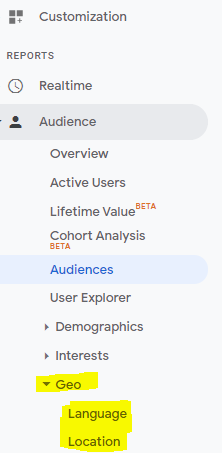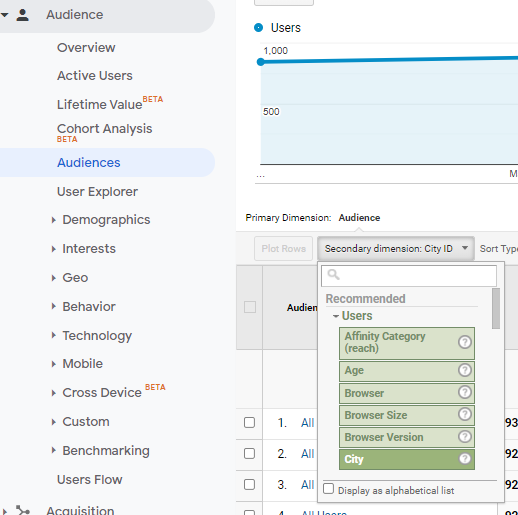
Top Takeaways:
You have come to the realization that localization is important because it goes beyond translation by accounting for cultural differences, customs and norms of the region you are targeting. You also realize you need a website localization strategy for scaling your content. Fear not, we are here to help with 4 tips on how to localize a website.
1) Study Your Website Metrics
When focusing on how to localize a website, it is essential to pay attention to your site metrics. A deep dive into Google Analytics is the quickest way to determine which languages will have the most impact. This should be the first step in the localization process.
The general rule is if at least 5% of your web traffic comes from another country it is time to do more research and see if localizing will be beneficial.
Some questions to ask before localizing:

Google Analytics’ “Audiences” section has user language and location data.
A couple of takeaways from this list: The first is that you should be focusing on a region, rather than a specific country, because many different languages are spoke in a given country.
Typically, media and television entities use the more formal version of a given language because it has the most reach, but there could be instances where a dialect is more impactful. You will need to make this part of your research efforts.
Moreover, you need to make sure the dates, currencies and units of measure are correct for this region. Formatting is core to internationalization, which is the process of making sure the backend of your website is capable of serving different regions. This process includes international domains, which we discussed in our last blog.
Once you have figured out the language and adjusted for the format, you need to decide if you will translate and localize the entire site, or just a few pages. The simplest answer is no, you do not have to localize every page, but the way to decide is through researching your web traffic. Google Analytics allows you to view traffic to specific pages of a site.
If consumers in a particular region of the world are interested in one or two specific pages on your website, make sure to localize them. Google Analytics makes it easy to see from where — down to the city — users are viewing your most-visited webpages.

You can pinpoint the location of users in the “Audiences” section by choosing the “secondary dimension” filter.
SEO Translation is crucial part of this process. You will want to optimize those pages based on traffic data because certain terms are less common in other countries. In the U.K., a search for “trainers” will not show a list of personal trainers as you might expect it would in the U.S.
Instead, it will show you the latest pair of Nikes. Why? People in that region refer to sneakers as “trainers.”
Another critical part of this process is cross-referencing website metrics with your sales team for additional consumer insights.
Research competitor websites to see what content might be working and try to mimic that. If you know that a competitor is already established in a particular region, you can examine their content to see what resonates most with consumers.
What languages does their website support? What does their webpage layout look like? Does their website design differ based on the country? What does the featured area look like? These additional insights can prove invaluable when it comes to scaling your business through localization strategies.
It pays to look at competitors to see:
There is no question that branding can be integral to a company’s success. Coca-Cola remains one of the largest beverage companies globally, and it is in part because they have created some of the most iconic marketing campaigns in advertising history.
While your organization should never abandon its core brand messaging, it might be time to revisit how your message resonates with customers.
You may find that you are getting many visitors from a particular country, but they are not converting. This usually means that there is a branding or messaging issue. If you want to successfully scale, you have to make sure that your content is sending the right message.
The process of altering marketing campaigns or slogans to make them more culturally relevant is called transcreation. It differs from localization because you are recreating an entirely different piece of content or slogan that is adjusted to account for what will resonate in that region.
When it comes to localization, transcreation and any other translation need, iTi is ready to help. We have 10,000 linguists who live all over the world and are ready to help you reach those new markets.
The original version of this page was published at: https://blog.ititranslates.com/2021/05/27/4-tips-on-how-to-localize-a-website/
Our healthcare language services ensure compliance by the Joint Commission and improved patient satisfaction. iTi's suite of health language services enables seamless contact between patients and m... Read more
Are you considering taking your business global?Whether you sell a product or a service, exporting to countries outside of the US has countless benefits.But, wait…When ...read more
The cultural fabric of the United States is changing more rapidly than ever before. As the make-up of the American population continues to change, so do the methods healthcare providers ...read more
Key Takeaways:54% of adults read below a 6th-grade levelPlain Language is a clear, concise way of writing that promotes better understandingPlain Language is essential in the healthcare ...read more
Virtual calls are not only commonplace these days, but most of us have become pros at them. Did you know you can include an interpreter on these calls to help your Limited English ...read more